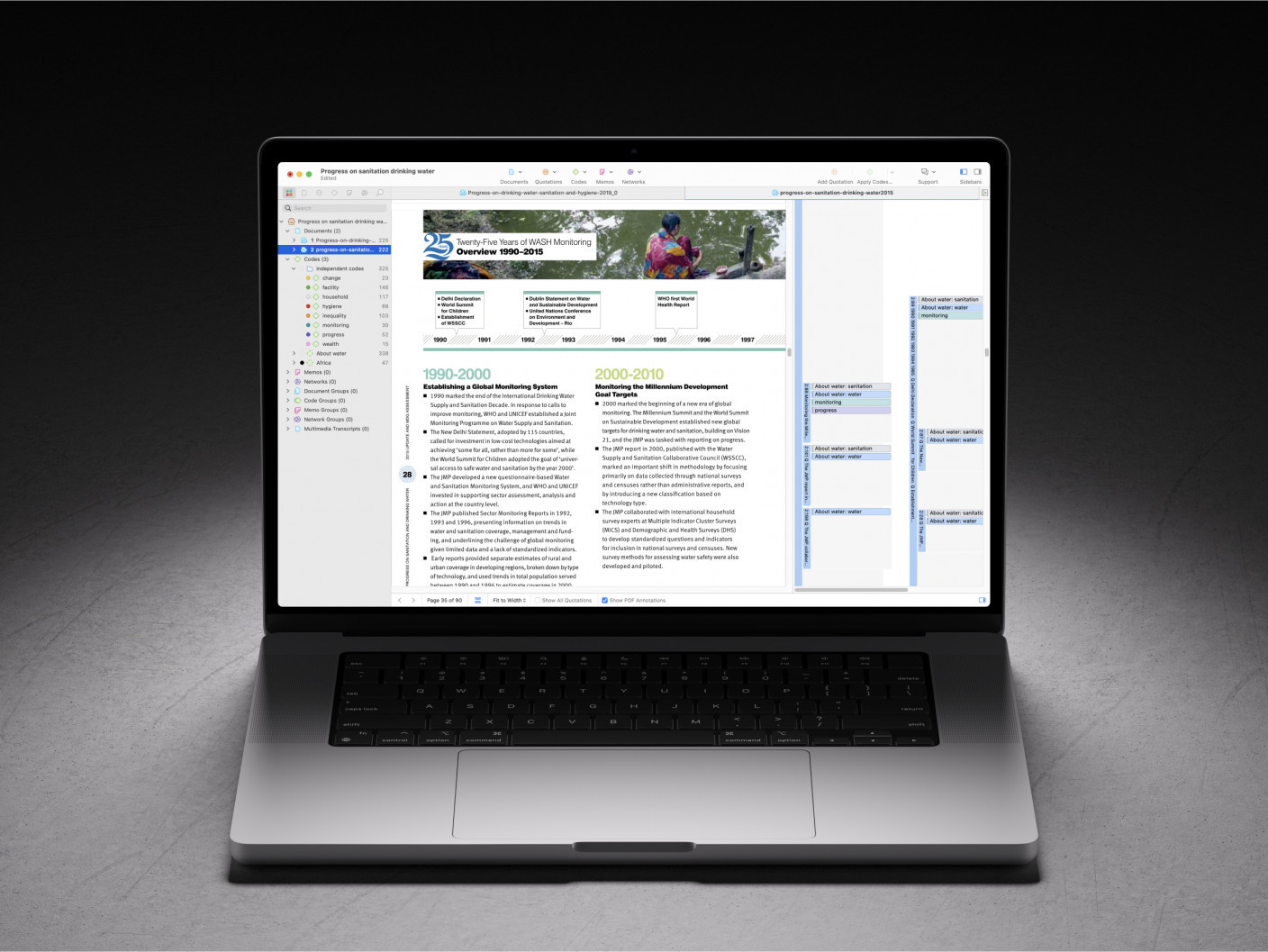Get to the Point with AI Summaries: Discover Key Insights Fast with Artificial Intelligence
- AI Summaries Beta: Making it easy to understand large data sets quickly
- Using AI Summaries
- Get a head start
- Focus your coding
- Synthesize knowledge from your data
- Conclusion
AI Summaries Beta: Making it easy to understand large data sets quickly
Dealing with tens or hundreds of pages of data can be time-consuming and tedious. Sometimes, you simply need to identify the key insights. Other times, you just need to be pointed in the right direction for data analysis. Whatever your needs, ATLAS.ti’s AI tools can help you get to the point faster.
This article will look at ATLAS.ti’s new AI Summaries tool, currently in beta and available to all ATLAS.ti users. Artificial intelligence holds profound implications for qualitative research, and thanks to our collaboration with OpenAI, qualitative data coding and analysis is faster and easier than ever before. Our new AI-powered tool helps to summarize large sets of data to provide succinct descriptions of your text that you can use at various stages of your research project.
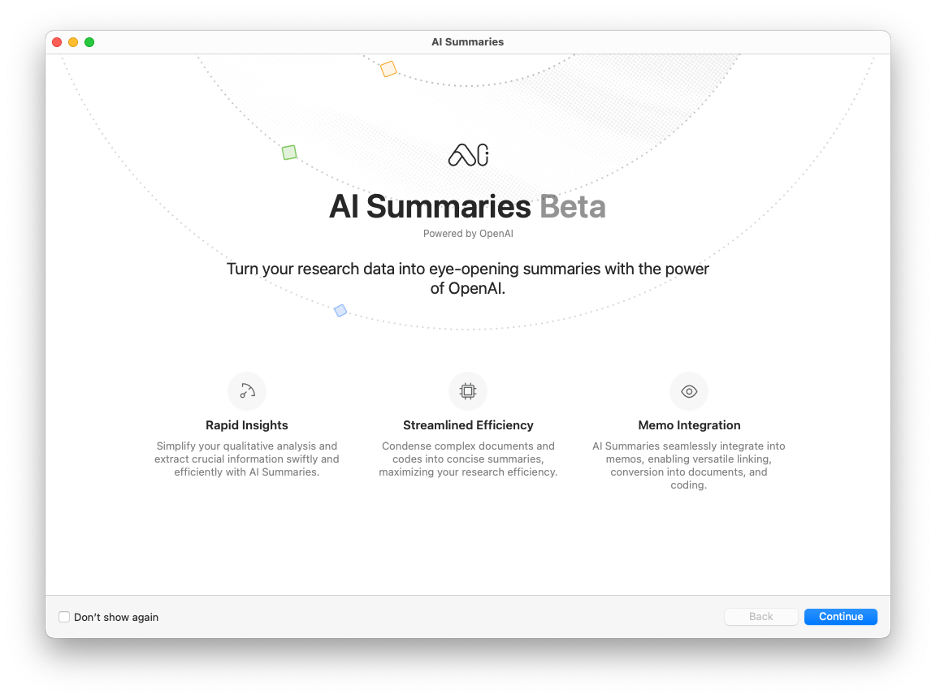
Let’s apply AI Summaries to a research project on sustainability and sustainable living. We will look at the basics of using AI Summaries, examine what goes into a summary memo, use it to apply codes to our data, and identify important patterns across the data.
Using AI Summaries
The AI Summaries tool works on all text documents or codes that are applied to text. Simply click on AI Summaries in the toolbar or select Analysis -> AI Summaries from a document’s pop-up menu. The AI Summaries dialog lists all the documents and coded data that you can send to OpenAI’s language models (safely and securely, so your data is protected). Choose the data that you want to analyze, and AI Summaries will return an estimated time for processing your data and completing your summaries.
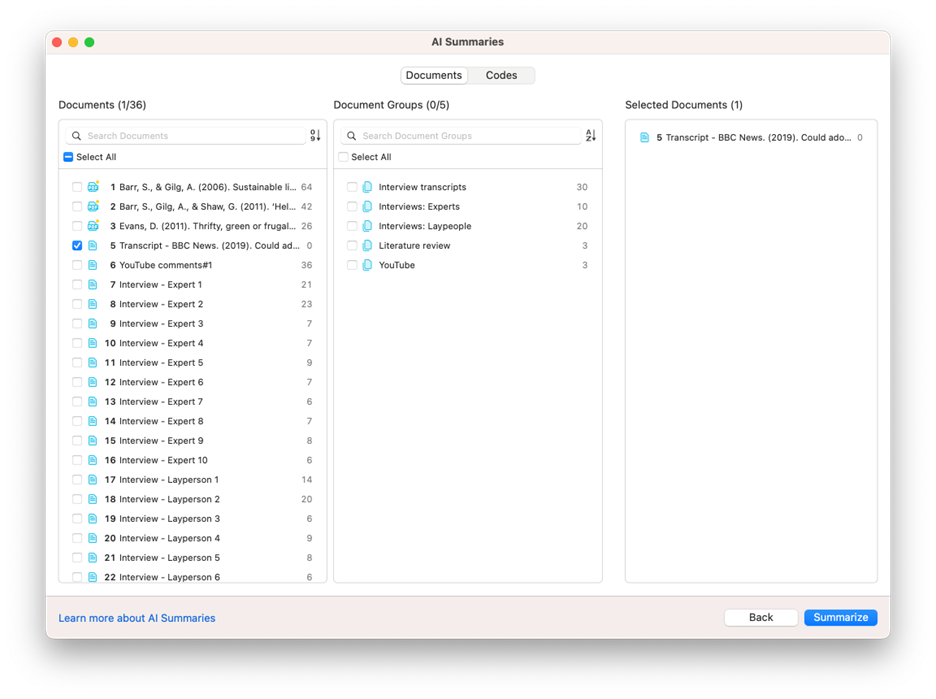
Our sustainability project contains text from three interviews on sustainability. All of this data took less than one minute for AI Summaries to process and summarize. Naturally, however, the larger your data set, the more time it will take to process. Whatever amount of time is necessary, you are free to put the AI Summaries tool in the background and perform other tasks on your project while your data is processing.

When AI Summaries is ready, it will provide you with a results dialog showing AI-generated summaries of your data in the form of memos. Memos in ATLAS.ti are a great way to document reflections, theoretical insights, and data analysis guidance for your project, so we have created a space for AI summaries in your project memos. Feel free to review these summaries in the results dialog or in Memo Manager and make corrections as necessary. Generative AI is always in development and, while it does well in understanding text, the human element will always be important to qualitative data analysis. In this case, you can edit these new summaries if and when AI Summaries misses any fine-grained but salient details.
Get a head start
Now that you have AI-generated summaries for your project, the next question is what to do with them. As with all AI tools in ATLAS.ti, you can use them as little or as much as you need to achieve your research goals. Turn a 10,000-word document into a one- or two-paragraph summary when you just need to know what your text is all about. Simply put, AI Summaries can help you save time in the search for key insights from your data.
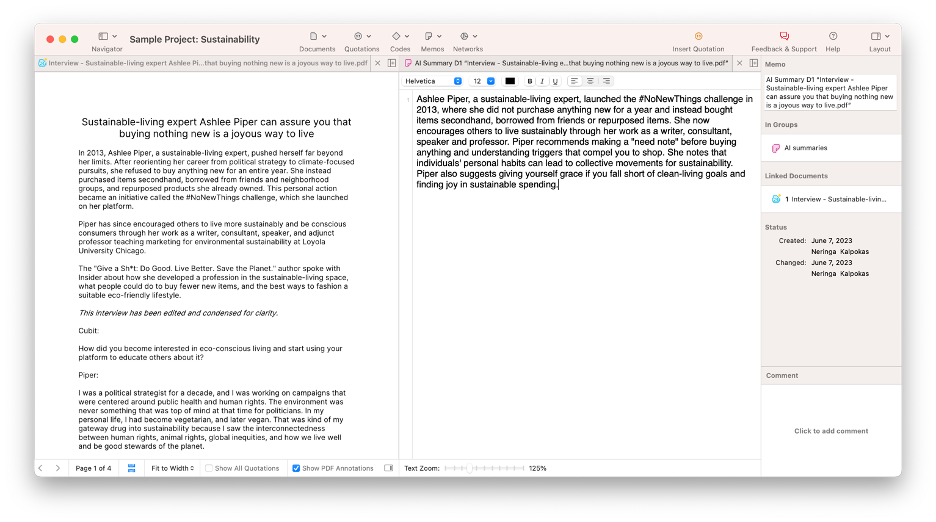
What goes into this summary? OpenAI’s language models look at a number of factors to determine what information is and isn’t important, such as text structure, repetition, and supporting details. Take a look at Piper’s description of a “need note” in both the original document and the AI-generated summary in the screenshot above, for example. AI Summaries identifies words like “recommend” as a signal for ideas that require emphasis. It also looks at the details used to explain the need note, indicating that the need note is less a passing idea and more of a key idea. Understanding how this and other summaries are generated, you can get a sense of the power AI Summaries has in identifying essential insights in your data.
Focus your coding
Line-by-line inductive coding is an essential skill in qualitative research, but it can also be challenging to figure out which codes are worth creating. With AI Summaries, you gain a guiding hand that points you to what you could code, facilitating the coding process and enabling you to conduct more efficient data analysis.
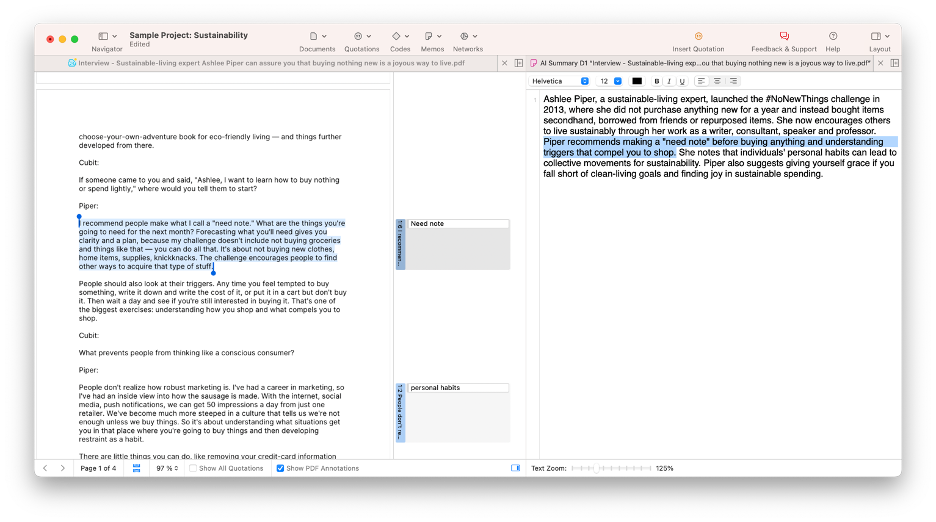
The summarization capabilities of OpenAI’s language models focus solely on the text you provide them and thus identify insights from the data itself. As a result, you can use a summary memo as guidance for your coding.
Looking at the screenshot above, you can see that AI Summaries has identified personal habits as key to sustainability. We can then apply a code to quotations that discuss personal habits to organize and view our data in one place. In the screenshot below, you can see all the data relevant to personal habits organized under one code and listed in one window.
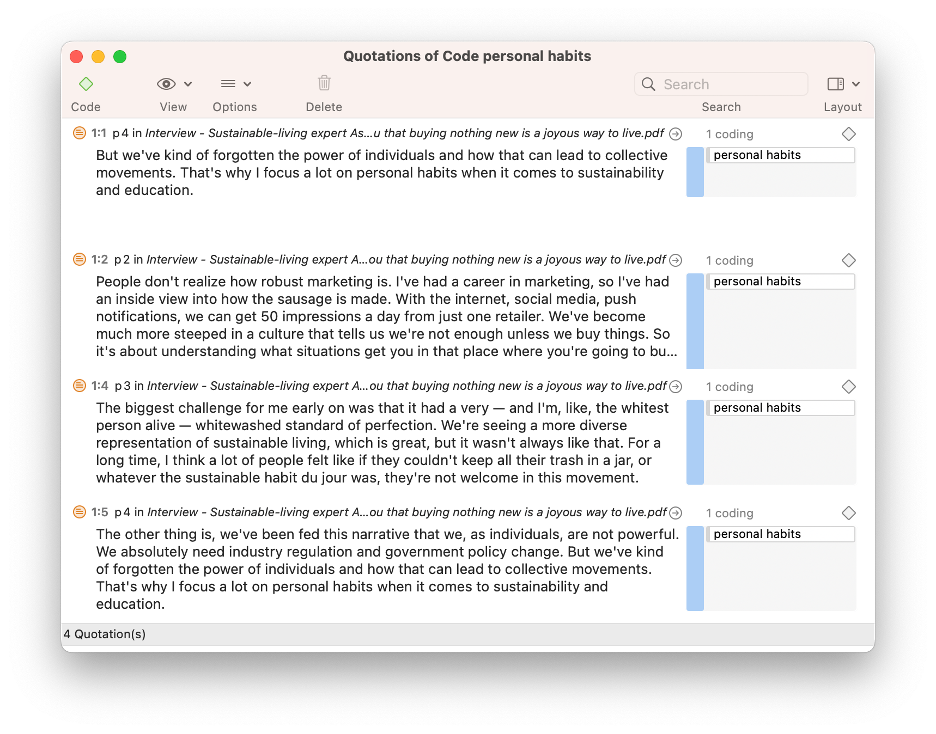
One of the main challenges to analyzing unstructured qualitative data is that key insights cannot always be identified in a predictable manner. AI Summaries not only shows you the essential points in your data but can also help you organize your data so that all that important information is easy to find.
Synthesize knowledge from your data
The Word Frequencies tool in ATLAS.ti is great for conducting content analyses of your data. However, word counts on a full body of information might include words that are not pertinent to your analysis. For example, think about a transcript, where the names of speakers appear multiple times. Imagine a research article where the text of the headers and footers are repeated on every page. Counting these words might interfere with the frequencies used to represent your themes.
The memos you generate from AI Summaries, however, focus only on the key insights. They can be converted into documents that can be coded and analyzed. You can then analyze these memos in Word Frequencies and Concepts to determine which words and phrases are most prevalent in your data.
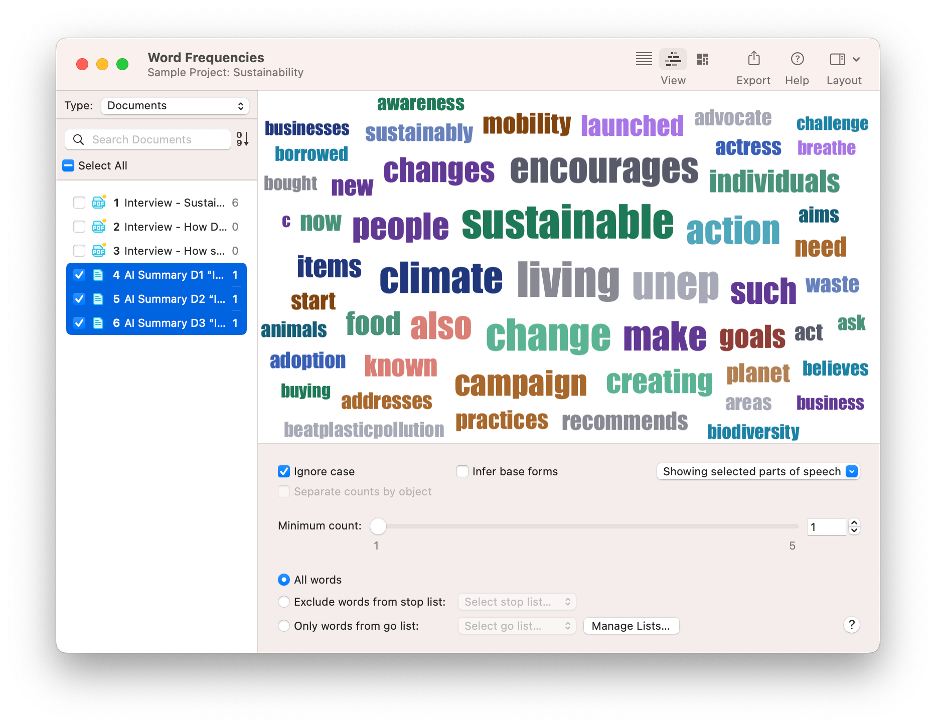
This analysis of the summaries focuses only on the most relevant information in your data, and the results display the most frequently occurring keywords to the center of the word cloud.
Using AI Summaries in conjunction with AI Coding can also be a great way to highlight the themes arising from your data. Use AI Coding to apply suggested codes to each of your summaries to reduce your data to a set of short but descriptive keywords.
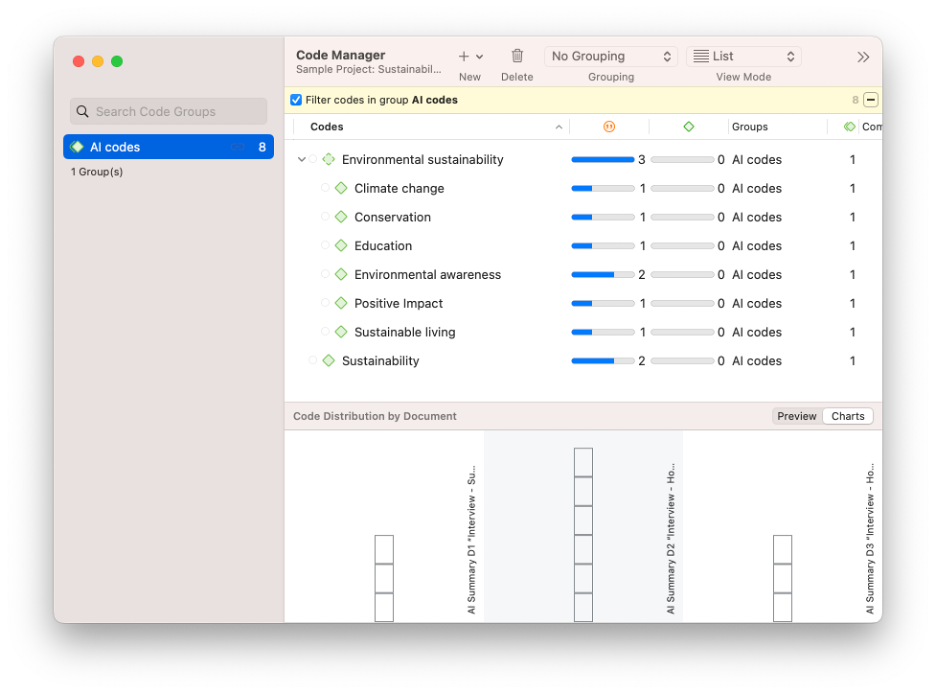
AI Coding, when used with AI Summaries, affirms that environmental sustainability is the overarching theme in each interview. Each of the three interviews in this project looks at sustainability from different angles such as climate change, conservation, and environmental awareness. This is useful because, if your research inquiry is focused on a specific strand of environmental sustainability, then you can focus only on the documents whose summaries are coded with that specific strand.
Finding ways to reduce your qualitative data can prove especially beneficial to those conducting literature reviews or document analysis. When you have dozens or hundreds of documents and need to get a bird’s-eye view of the themes and patterns in your data, AI Summaries can be a valuable research assistant that can help you with synthesizing knowledge across your entire project.
Conclusion
Research can be a time-consuming process when you don’t know where to begin or even what you are looking for while sifting through your data. It can be challenging to identify key insights that can help you address your research question. ATLAS.ti’s AI-assisted tools, such as AI Summaries, can help you get to the point faster. As always, tools like AI Summaries are aids for your research; it is ultimately up to the researcher to explain the insights from their data to their audiences. However, AI Summaries and AI Coding can be great assistants that help you conduct faster and more efficient research.


